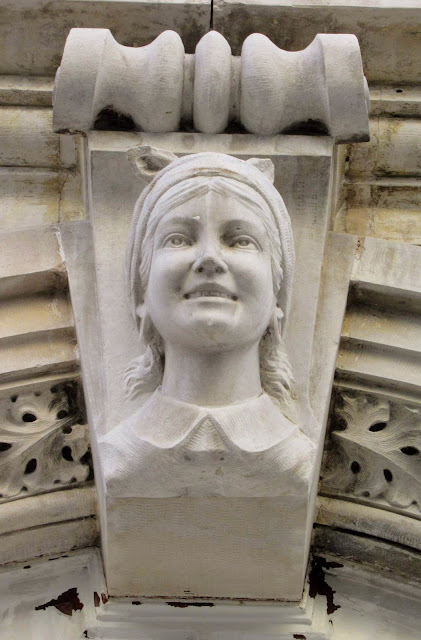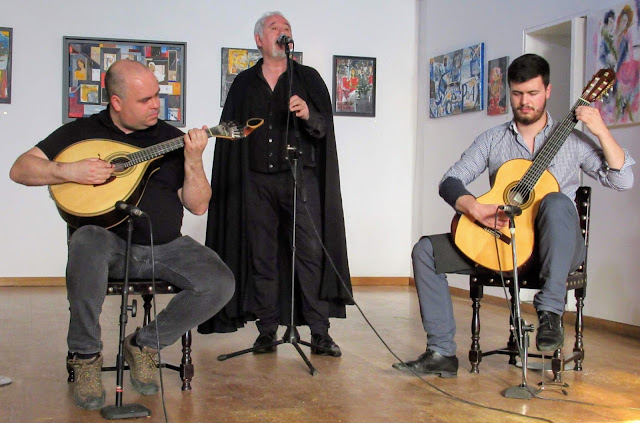Coimbra, the former capital city of Portugal, with many preserved medieval buildings and the unique ambiance of a university town sits on the banks of the River Mondego.
Until now the temperature in Portugal has been cool and mostly cloudy. Today is 28 degrees and not a cloud in the sky. Everyone is out enjoying the day.
 |
Peaceful walkway through an urban park |
Lots of resting places
 |
| A water feature |
The 600-foot pedestrian bridge below that joins parks on either side of the river, is named for Pedro, the Crown Prince of Portugal, acknowledging his affair with the Queen's Lady-in-Waiting, Ines de Castro. The bridge, at first sight, seems an engineering impossibility: two cantilevered walkways joined in the middle, each designed to hold up the other, but are displaced from one another, making it look like they don't meet. The coloured glass is a delightful touch.
 |
| Ponte Pedro e Ines |
 |
| Ah, Spring |
Made from recycled materials
 |
| 1 of 2 vehicular bridges |
 |
Our Airbnb is perched high above the old town...2 long steep alleys down, 96 stairs then 2 more even steeper alleys and we land in the heart of ancient Coimbra.
It's a perfect afternoon for a boat ride on the river. Only 7 euros for a 45-minute journey on the O Basofias:
Today our souls are touched by the heart of Portuguese music, Fado. A performance inside this centuries-old Cafe Santa Cruz, a former chapel with high vaulted ceilings providing acoustics that heightens the experience:
Turn on your volume. Here is a small taste of the performance:
The history of Fado is long (at least since the 1800s) and with differing interpretations of its origins and meanings. To learn more: https://www.visitlisboa.com/node/7019
The man below is playing a Portuguese guitar with 12 steel strings and its unique tuning mechanism (the watch key tuner). It's most commonly used in Fado but is also played in other types of music.
The guitar played by this man has a unique bass sound. The musician wears a special non-slip towel over his right thigh and cuff on his right arm to steady the guitar in an upright playing position.
Portuguese guitar as art:
In a nearby window, safely guarded by electronic eyes and sensors, stands this Portuguese guitar in gold filigree:
In a nearby window, safely guarded by electronic eyes and sensors, stands this Portuguese guitar in gold filigree:
In a public space stands this sensuous version of the iconic guitar. Genius how her fingers symbolize the turning mechanism.
Our last day in Coimbra is for the inner child. It's off to "Portugal dos Pequenitos". This is a place of miniatures. The first section is to acknowledge all of the countries that early Portuguese explorers discovered: Africa, Angola, Brazil, Cape Verde, Macao, India, East Timor, the Azores, Madeira and others. There is a building dedicated to each country, with cultural pieces from that country.
The next section unbelievably replicates in detail buildings and monuments that are in Coimbra. These replicas have doorways large enough that children can enter to explore, while parents and grandparents wait patiently (or not) outside. The building replicas range from typical homes, chapels, mills and pillories to historical buildings:
There is a building with an exhibit called "From wood to plastic, the advent of building toys"
Finally, there is a building with dolls 12 to 14 inches tall who resemble historical figures and who are all dressed in clothes of the time.
The doll in the bottom right photo above is Vasco da Gama, Portugal's famous explorer.
Random Photos from "the Miniatures":
Morning is child's play and the afternoon is off to the University of Coimbra, one of the oldest universities in continuous operation in the world. Founded in 1290 it's now a UNESCO World Heritage site. It has eight diverse faculties and 20,000 students at the undergraduate, graduate and doctoral levels.
Usually, tours (ten euros for seniors) are available to see some very special rooms inside as well as the botanical gardens, but today is Easter Sunday. Some rooms are open and some are not. Revenue from the tours supports the university.
To see some of the splendour: Wikipedia
Outside the statues, open spaces, plazas and views of this place are as magnificent as the buildings themselves.
Tomorrow we take the train to Porto and the Duoro Valley for our last week in Portugal. Three weeks have flown by. This is such an easy country to travel in. People everywhere are warm and welcoming.
Random Photos of Coimbra:
A fellow rolls up on the Royal Enfield pictured below. After a nice chat, we end up seeing this Citroen and retired service scooter, now a planter.
The Hotel Astoria below:
The beautiful organ in a church:
.









































Beautiful Fado...wesat in the same cafe and listened to the music...the Grand Plaza at the University is...well...Grand!
ReplyDelete